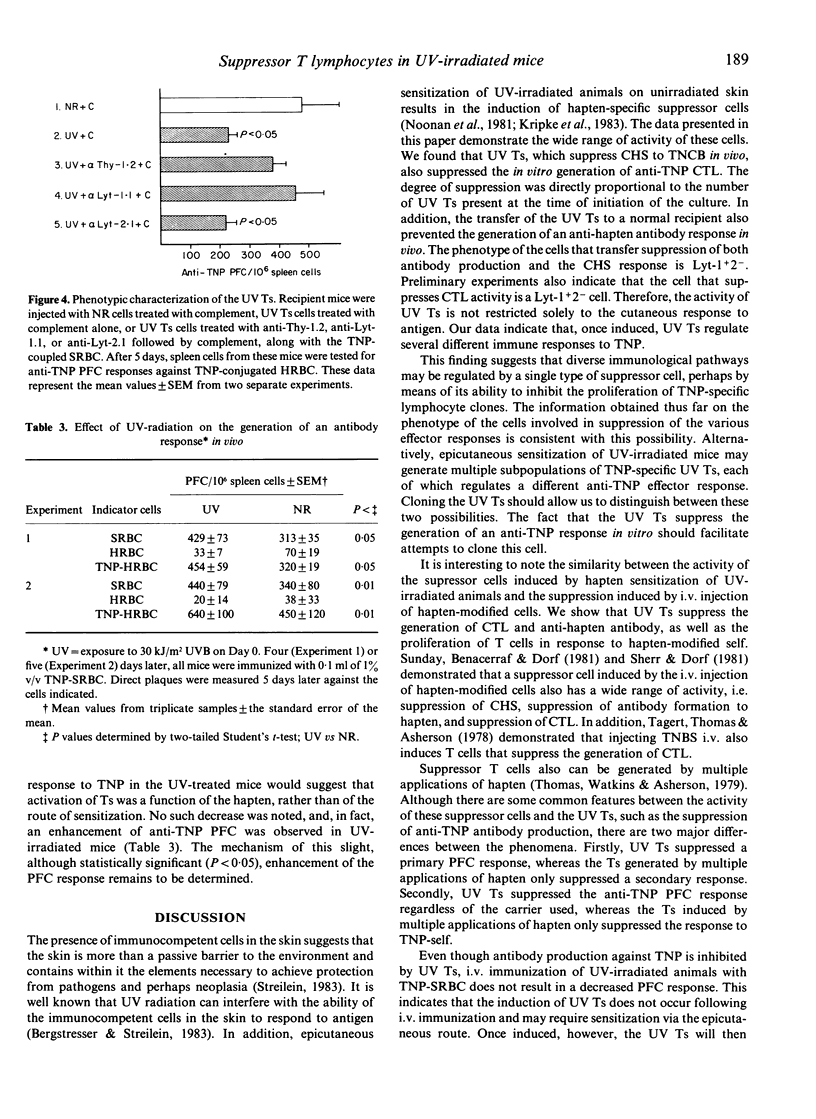Abstract
The purpose of this study was to determine whether the formation of hapten-specific suppressor T lymphocytes induced by the epicutaneous sensitization of UV-irradiated mice could suppress other hapten-specific immune responses in addition to contact hypersensitivity (CHS). Suppressor cells were induced by applying trinitrochlorobenzene (TNCB) to the unexposed skin of mice irradiated several days earlier with 40 kJ/m2 UVB (280-320 nm) radiation. Previous work demonstrated that the spleens of such animals contain Lyt-1+, 2-T lymphocytes which prevent the induction of CHS to TNCB when transferred to normal mice, and inhibit proliferation of normal lymphocytes in vitro to TNP-modified syngeneic cells. These studies show that addition of T lymphocytes from UV-irradiated, TNCB-sensitized mice to cultures of normal lymphocytes and TNP-modified syngeneic cells inhibited the generation of TNP-specific cytotoxic T lymphocytes (CTL). The inhibition was dose-dependent and occurred only when the suppressor cells were present during the first 24 hr of culture. The suppressor cells had no effect on the activity of preformed CTL. In addition, injection of the suppressor lymphocytes into mice at the time of i.v. injection of TNP-modified sheep red blood cells (TNP-SRBC) reduced the number of direct plaque-forming cells against TNP, but had no effect on the production of antibody against SRBC. Cells that inhibited anti-TNP antibody formation were Thy-1+, Lyt-1+, 2-. These results indicate that hapten-specific suppressor cells from UV-irradiated mice prevent the activation of several different hapten-specific immunological pathways.
Full text
PDF





Selected References
These references are in PubMed. This may not be the complete list of references from this article.
- Bergstresser P. R. Ultraviolet radiation produces selective immune incompetence. J Invest Dermatol. 1983 Aug;81(2):85–86. doi: 10.1111/1523-1747.ep12542059. [DOI] [PubMed] [Google Scholar]
- Esophageal cancer studies in the Caspian littoral of Iran: results of population studies--a prodrome. Joint Iran-International Agency for Research on Cancer Study Group. J Natl Cancer Inst. 1977 Oct;59(4):1127–1138. [PubMed] [Google Scholar]
- JERNE N. K., NORDIN A. A. Plaque formation in agar by single antibody-producing cells. Science. 1963 Apr 26;140(3565):405–405. [PubMed] [Google Scholar]
- Jensen P. J. The involvement of antigen-presenting cells and suppressor cells in the ultraviolet radiation-induced inhibition of secondary cytotoxic T cell sensitization. J Immunol. 1983 May;130(5):2071–2074. [PubMed] [Google Scholar]
- Julius M. H., Simpson E., Herzenberg L. A. A rapid method for the isolation of functional thymus-derived murine lymphocytes. Eur J Immunol. 1973 Oct;3(10):645–649. doi: 10.1002/eji.1830031011. [DOI] [PubMed] [Google Scholar]
- Kripke M. L., Fisher M. S. Immunologic parameters of ultraviolet carcinogenesis. J Natl Cancer Inst. 1976 Jul;57(1):211–215. doi: 10.1093/jnci/57.1.211. [DOI] [PubMed] [Google Scholar]
- Kripke M. L. Immunologic mechanisms in UV radiation carcinogenesis. Adv Cancer Res. 1981;34:69–106. doi: 10.1016/s0065-230x(08)60239-0. [DOI] [PubMed] [Google Scholar]
- Kripke M. L., Morison W. L., Parrish J. A. Systemic suppression of contact hypersensitivity in mice by psoralen plus UVA radiation (PUVA). J Invest Dermatol. 1983 Aug;81(2):87–92. doi: 10.1111/1523-1747.ep12542071. [DOI] [PubMed] [Google Scholar]
- Mishell R. I., Dutton R. W. Immunization of dissociated spleen cell cultures from normal mice. J Exp Med. 1967 Sep 1;126(3):423–442. doi: 10.1084/jem.126.3.423. [DOI] [PMC free article] [PubMed] [Google Scholar]
- Noonan F. P., De Fabo E. C., Kripke M. L. Suppression of contact hypersensitivity by UV radiation and its relationship to UV-induced suppression of tumor immunity. Photochem Photobiol. 1981 Dec;34(6):683–689. [PubMed] [Google Scholar]
- Rittenberg M. B., Pratt K. L. Antitrinitrophenyl (TNP) plaque assay. Primary response of Balb/c mice to soluble and particulate immunogen. Proc Soc Exp Biol Med. 1969 Nov;132(2):575–581. doi: 10.3181/00379727-132-34264. [DOI] [PubMed] [Google Scholar]
- Shearer G. M. Cell-mediated cytotoxicity to trinitrophenyl-modified syngeneic lymphocytes. Eur J Immunol. 1974 Aug;4(8):527–533. doi: 10.1002/eji.1830040802. [DOI] [PubMed] [Google Scholar]
- Sherr D. H., Dorf M. E. Hapten-specific T cell responses to 4-hydroxy-3-nitrophenyl acetyl. IX. Characterization of Idiotype-specific effector-phase suppressor cells on plaque-forming cell responses in vitro. J Exp Med. 1981 Jun 1;153(6):1445–1456. doi: 10.1084/jem.153.6.1445. [DOI] [PMC free article] [PubMed] [Google Scholar]
- Spellman C. W., Anderson W. L., Bernhard E. J., Tomasi T. B. Suppression of antibody responses to topically applied antigens by ultraviolet light irradiation. Induction of phototolerance. J Exp Med. 1984 Dec 1;160(6):1891–1900. doi: 10.1084/jem.160.6.1891. [DOI] [PMC free article] [PubMed] [Google Scholar]
- Spellman C. W., Daynes R. A. Modification of immunological potential by ultraviolet radiation. II. Generation of suppressor cells in short-term UV-irradiated mice. Transplantation. 1977 Aug;24(2):120–126. doi: 10.1097/00007890-197708000-00005. [DOI] [PubMed] [Google Scholar]
- Spellman C. W., Woodward J. G., Daynes R. A. Modification of immunological potential by ultraviolet radiation. I. Immune status of short-term UV-irradiated mice. Transplantation. 1977 Aug;24(2):112–119. doi: 10.1097/00007890-197708000-00004. [DOI] [PubMed] [Google Scholar]
- Streilein J. W. Skin-associated lymphoid tissues (SALT): origins and functions. J Invest Dermatol. 1983 Jun;80 (Suppl):12s–16s. doi: 10.1111/1523-1747.ep12536743. [DOI] [PubMed] [Google Scholar]
- Sunday M. E., Benacerraf B., Dorf M. E. Hapten-specific T cell responses to 4-hydroxy-3-nitrophenyl acetyl. VIII. Suppressor cell pathways in cutaneous sensitivity responses. J Exp Med. 1981 Apr 1;153(4):811–822. doi: 10.1084/jem.153.4.811. [DOI] [PMC free article] [PubMed] [Google Scholar]
- Sy M. S., Miller S. D., Claman H. N. Immune suppression with supraoptimal doses of antigen in contact sensitivity. I. Demonstration of suppressor cells and their sensitivity to cyclophosphamide. J Immunol. 1977 Jul;119(1):240–244. [PubMed] [Google Scholar]
- Tagart V. B., Thomas W. R., Asherson G. L. Suppressor T cells which block the induction of cytotoxic T cells in vivo. Immunology. 1978 Jun;34(6):1109–1116. [PMC free article] [PubMed] [Google Scholar]
- Thomas W. R., Watkins M. C., Asherson G. L. Suppression of antibody responses by cells from mice painted with picryl chloride. Immunology. 1979 Apr;36(4):843–850. [PMC free article] [PubMed] [Google Scholar]
- Toews G. B., Bergstresser P. R., Streilein J. W. Epidermal Langerhans cell density determines whether contact hypersensitivity or unresponsiveness follows skin painting with DNFB. J Immunol. 1980 Jan;124(1):445–453. [PubMed] [Google Scholar]
- Ullrich S. E., Kripke M. L. Mechanisms in the suppression of tumor rejection produced in mice by repeated UV irradiation. J Immunol. 1984 Nov;133(5):2786–2790. [PubMed] [Google Scholar]
- Ullrich S. E. Suppression of lymphoproliferation by hapten-specific suppressor T lymphocytes from mice exposed to ultraviolet radiation. Immunology. 1985 Feb;54(2):343–352. [PMC free article] [PubMed] [Google Scholar]


